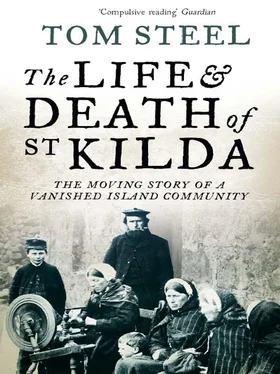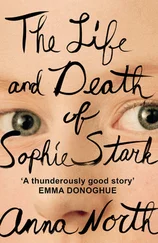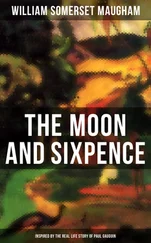In the summer months, the puffins were the main source of food. Mrs Munro, the wife of the last missionary, remembers how they tasted when she tried to cook them. ‘The first lot of puffins (of the season) were brought by the postmaster. They were all dressed, ready for cooking. I asked Nurse Barclay how to cook them and she said put them in the oven and roast them. My husband was in school and came home to dinner and he said, “Try them”. I said, “No thanks, I’ve had enough – I’ve roasted them.” I went to empty the tin and each time I emptied it nothing but oil would come out till you got fed up with seeing it.’
‘The gannets we ate’, recalls Neil Ferguson, ‘tasted fishy and salty.’ Like the fulmar, the gannet was normally salted down for eating in winter. Ferguson recalls: ‘You had to steep them in water for twenty-four hours to take the salt out of them, and then boil them with tatties for your dinner.’ The guga, in fact, was not a food peculiar to St Kilda: the birds were regarded by some on the mainland as delicacies and were regularly served by ships’ cooks on the steamers that plied the Western Isles.
The islanders also ate large quantities of eggs, which, one visitor remarked, ‘they just eat as the peasantry eat potatoes’. Gathered in the spring months, the eggs were boiled and eaten immediately, or else preserved in barrels. The St Kildans were never too fussy about the freshness of the eggs, often keeping them for six to eight weeks before eating them because, they said, time added to their flavour.
The most important possessions on Hirta, used and maintained by the community as a whole, were the boats. Without them, the St Kildans could hardly have existed. They depended upon being able to make the frequently hazardous journey to Boreray and the great stacs to trap the thousands of sea birds that were their livelihood.
At the end of the seventeenth century, the community owned one boat only, sixteen cubits long. It was divided into sections, proportional to the number of families on the island at the time, and every householder was responsible for providing a piece of turf large enough to cover his section of the boat in summer to prevent the hot sun from warping and rotting the precious wooden shell. In winter, the boat was dragged up high above the water line and filled with rocks so that it would not be swept away in a storm or dashed against the rocks.
By 1831, the St Kildans were having to make do with an awkward ship’s boat, weighing almost three tons. Although the boat had three oars either side, the St Kildans made a square mainsail out of their own cloth. Because each family had been responsible for making its share of the sail, the final product was made up of twenty-one patches of various sizes and shades, ‘like what you would have fancied Joseph’s coat to have been’, wrote George Atkinson. The islanders had given their boat a nickname – Lair-Dhonn (Brown Mare).
Ten years later, there was still one boat on Hirta, although the advantages to the community of possessing a second were being talked about by philanthropists on the mainland. In 1861, at a cost of £60, the St Kildans were presented with a fine, new, fully equipped boat. The Dargavel, as she was called, was tragically lost at sea with all hands two years later.
By May 1877 there were four boats on Hirta. Two were given to the people by a wealthy visitor and the others, although almost new, were not thought by the St Kildans to be strong enough to withstand rough usage.
Never in their history did the St Kildans build a boat of their own. Although each household possessed a hammer, and one islander, it is said, had a complete set of carpenter’s tools, there was no indigenous supply of wood on Hirta. It was just as easy therefore to transport a finished boat from the mainland as it was to bring over the materials from which one could be built. The men did their best to repair the boats they had, although many from the mainland thought they did so in a less than enthusiastic way.
Like their cousins in the Hebrides, the St Kildans regarded the sea as a spirit to be wooed rather than a challenge. Although not thought to be particularly good sailors, they did at least respect the Atlantic Ocean surrounding them. ‘The St Kildans’, commented Wigglesworth in 1902, ‘are as expert in the art of managing their boats as they are in climbing the cliffs. I do not mean to say that they are specially expert sailors, but the skilful manner in which they bring their boats up to the rocks and land and re-embark in the face of a heavy swell, where few sailors would even care to risk their boats, is remarkable.’
Every year, the men of Hirta would make the dangerous trip to Stac Lee. It was agreed by the morning meeting that time and tide were right to risk a boat on the four-mile crossing. While the little rowing boat rose and fell with the swell of the ocean, the man in the bows would throw a rope towards the giant stac. ‘In the olden days,’ remembers Lachlan Macdonald, ‘there was a bolt put into the rock there. You’d be lucky sometimes when you were in the boat if you would see it.’ Once the rope was secured on the steel bolt, those who were to land scrambled from the boat onto the rock. ‘Everyone’, says Lachlan, ‘had to take an empty box. You’d carry it up to the top of Stac Lee and when you reached the top you would fill it up with gannets’ eggs.’ Several men would have to stay in the boat. There was no safe mooring by the rock, so they would try to seek as sheltered water as there was available and wait.
When all the St Kildans had filled their boxes, the most dangerous part of the exercise began. Carrying the boxes of eggs on their backs they would make the treacherous descent, ‘which was a worse job than going up’, recalls Lachlan. ‘There would be anything in the box from half a hundredweight to a hundredweight. And you hadn’t got to break them; you had to take them down whole. Maybe sometimes there would be an odd one broken, but there weren’t many.’ The boat, laden down with men and eggs, then returned to the safety of Village Bay. The women, by tradition, were always waiting at the landing-place to greet their exhausted men.
In the early days, eggs were rarely taken from Stac Lee. Most were removed from the nests of Boreray and Stac an Armin. The St Kildans reasoned that by leaving the eggs on Stac Lee, by autumn the young gannets would be more advanced there. A double crop of sea birds was thus assured. Should bad weather, moreover, prevent a crossing to Stac Lee at the appropriate time of year, there were always the birds on Boreray. At the time of the evacuation, Stac Lee was climbed for eggs and nothing else. By then it was too dangerous, given the number of men available, to risk a crossing.
The St Kildans took the eggs of some fourteen species of birds that bred on their archipelago. Some, like those of the gannet and the guillemot, were for eating, others were blown and sold to tourists in the summer months or sent to egg collectors on the mainland. The eggs of the starling, oyster catcher, tree sparrow, fork-tailed petrel, grey crow, raven, and eider duck were frequently asked for, but the greatest prize was the egg of the St Kilda wren – a species of wren slightly larger than the mainland varieties, that was found only on Hirta. After all the eggs were harvested, they were laid out in boxes on the grass and divided out among the islanders. Most homes owned a glass blowpipe brought over from Scotland which was used to remove the contents of the eggs.
Puffins, the major source of fresh food throughout the summer months, arrived in March and remained on Soay and Dun until the end of August. The birds made their nests in the turf. The female laid her single egg at the end of a burrow, usually three or four feet long, dug by both birds. Until recently, it was estimated that the puffin population of St Kilda was over a million; but in the past two years the number has more than halved, and there is some mystery as to what has happened to the birds that never returned. It is thought that oil pollution out at sea has claimed them.
Читать дальше












